Home » Health in Ireland: Key Trends 2023
Minister for Health, Stephen Donnelly TD, published Health in Ireland: Key Trends 2023 at the end of February. It compiles summary statistics on various aspects of health and healthcare over the past ten years, using national and international data to highlight national trends and compare Ireland among its European and global peers. This article from IPU Editorial Manager, Siobhán Kane provides an overview of the Report.

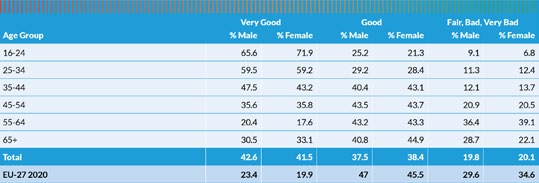
Ireland has the highest self-perceived health status in the EU, with 80 per cent of people rating their health as good or very good (see Table 1). The number of people reporting a chronic illness or health problem is also better than the EU average, at around 29.5 per cent of the population. However, health status reflects income inequality, with fewer low-income earners reporting good health both in Ireland and across the EU. Current life expectancy is 84 years for women in Ireland, and 81 for men.
The report showed that in-patient discharges and day cases had been increasing prior to the pandemic, after which there was a sharp reduction in both. In 2022, day cases were already higher than they were in 2019, whereas the recovery in in-patient discharges is happening more gradually and they are still lower than they were in 2013. The total number of people waiting for out-patient appointments decreased between September 2022 and September 2023, from 625,666 to 597,082.
For children there was an increase in the number on the in-patient waiting list, from 7,497 to 9,701.
Chapter 4 of Health in Ireland: Key Trends 2023 provides an overview of the primary care sector, including GP care, immunisation rates, blood donations, drug treatment and reimbursement services such as the Medical card, GP visit card, Drug Payment and Long -Term Illness (LTI) schemes. The number of medical card holders in 2022 was 15.4 per cent less than in 2013, as 30.4 per cent of the population had a medical card in December 2022, compared to 40.1 per cent in 2013.
Table 2: Primary care reimbursement service schemes, 2013-2022
Figure 1: Prescription items dispensed under the General Medical Services (GMS) scheme: No. of items dispensed and average cost per item, 2013–2022’
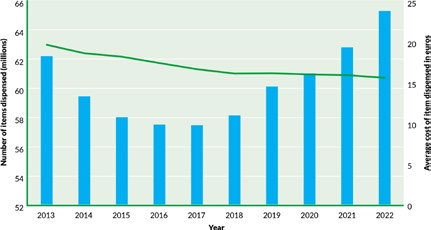
The percentage of the population participating in the Drugs Payment Scheme has increased by 5.9 per cent since 2013. However, there was a dip in the intervening years, with approximately 1.4 million on the Scheme in 2013, before falling to a low of 1.26 million in 2017. That figure has since risen to 1.65 million in 2022 (see Table 2), with an 8.4 per cent increase from 2021 to 2022.
Table 3 shows prescription items dispensed under the General Medical Services (GMS) scheme. While the number of items dispensed increased from 2017 to 2022, the average cost per item fell. This is due to the impact of the 2013 Health Pricing and Supply of Medical Goods Act, which introduced a range of measures in order to enable savings for the State and for patients, such as reference pricing and generic substitution.
The percentage of the population covered by private health insurance rose slightly and stood at 45.3 per cent in 2022. There has been a slight decrease (2.7 per cent) in the number of people residing in long-stay care facilities from 2017–2022, and almost half of these residents are over the age of 85.
The percentage of blood donors in the population decreased in 2020 and has largely remained at the same level since; the number of whole blood donations is also still below the level it was at in 2018.
On immunisation, in 2022 the uptake in the HPV vaccine was 69 per cent, which is higher than it was in 2017 (when the uptake was just above 51 per cent), but is still below that of 2014 when it stood at 88 per cent. Immunisation uptake rates for many illnesses remain stable and above 90 per cent, though Hib, Meningococcal, and MMR have all fallen in recent years (see Table 4.3).
Table 3: Immunisation rates, percentage uptake, 2013-2022
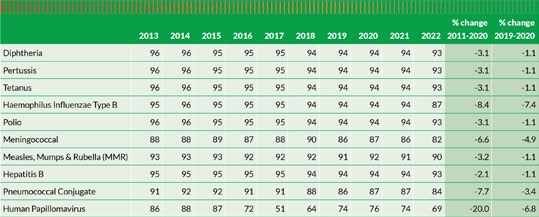
Ireland has the 14th highest health spend per capita across selected OECD countries. Ireland’s total current health expenditure as a percentage of GDP ranks sixth, behind France, Canada, the United Kingdom, Germany and the United Stated. This position is nineth when looking at public expenditure only. Figure 1 shows health expenditure by type of care as a percentage of total health expenditure in the EU15 in 2021.
Figure 2: Health expenditure by type of care as a % of total health expenditure, EU15 2021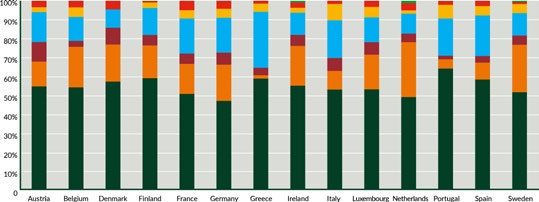
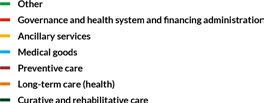
Overall, Community Healthcare Networks (CHNs) around Dublin and the other cities have a more favourable age structure in terms of health indicators. The Report states that while “the differences between CHNs are mostly marginal . . . even small differences at the population level can have an outsized impact on finite health resources.” Figure 2 shows deprivation levels in CHNs, and Figure 3 shows the percentage of the population reporting ‘good’ or ‘very good’ health by CHNs.
Figure 3: Deprivation by Community Healthcare Network (CHN), Census 2022
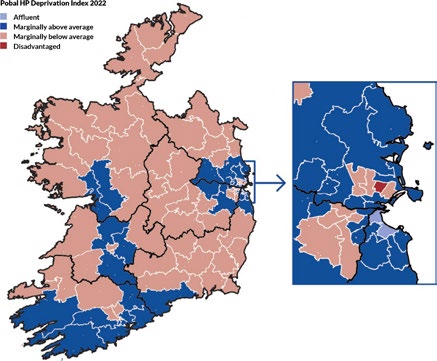
Figure 4: Percentage of the population reporting ‘good’ or ‘very good’ health by Community Healthcare Network (CHN), Census 2022
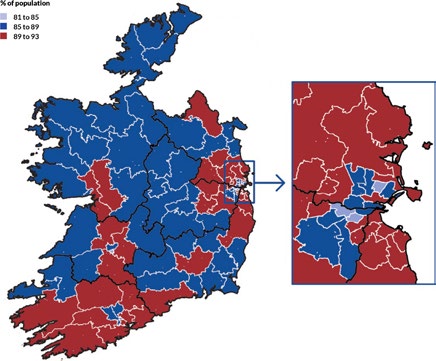
When publishing the Report, Minister for Health Stephen Donnelly said it, “gives us the opportunity to assess the performance of our health service and reflects on the health status of our people over time”. However, as has been the principal tenant of health policy discourse in recent years, Ireland’s ageing population will put additional pressure on our health service and data and planning are paramount to meet this challenge. Minister Donnelly said, “the largest proportionate increase in population over the next two decades is projected to occur among those aged 85 years and older, with the number of people aged 65 and over projected to grow from one-fifth to over one-third of the working population in the same period. Such demographic changes require a health service that is ever more efficient and productive.” He said, “timely and quality data is essential”, and put forward that the Health Information Bill, when enacted, will provide a framework for the collection of healthcare data, “enhancing patient care and safety, supporting public health management, enabling better planning and delivery of health services, supporting research and innovation, and facilitating the digital transformation of healthcare.”
Health in Ireland: Key Trends 2023 is available at gov.ie > Publications.
Siobhán Kane

Editorial Manager, IPU
Highlighted Articles